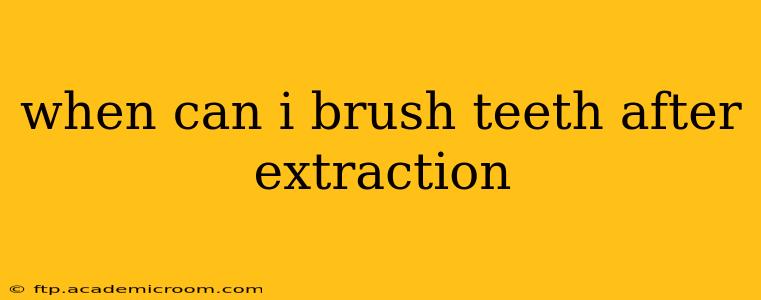When Can I Brush My Teeth After a Tooth Extraction?
The question of when to brush your teeth after a tooth extraction is a common one, and the answer isn't a simple "24 hours later." It's more nuanced and depends on the complexity of the extraction and the specific instructions from your dentist or oral surgeon. Ignoring proper post-extraction care can lead to complications like dry socket, infection, or delayed healing. Let's delve into the specifics.
How Soon After Extraction Can I Brush My Teeth?
Generally, you should wait at least 24 hours before brushing your teeth near the extraction site. However, this is a guideline, not a hard and fast rule. Your dentist will provide specific instructions based on your individual situation. Some factors influencing the waiting period include:
- Type of Extraction: A simple extraction of a visible tooth will likely have a shorter waiting period than a more complex surgical extraction involving bone removal or stitches.
- Presence of Stitches: If stitches are present, you'll need to wait longer before brushing near the area to avoid dislodging them. Your dentist will instruct you on how to carefully clean around them.
- Healing Progress: Your dentist might recommend waiting longer if the blood clot formation at the extraction site is slow or fragile.
What Should I Do in the First 24 Hours?
In the crucial first 24 hours, focus on gentle rinsing. Avoid vigorous rinsing or spitting, which can dislodge the blood clot that's essential for proper healing. You can rinse gently with salt water (1/4 to 1/2 teaspoon of salt dissolved in 8 ounces of warm water). This helps to keep the area clean and can reduce swelling. Avoid brushing or flossing near the extraction site.
How to Brush After 24 Hours?
After the initial 24-hour waiting period (or as instructed by your dentist), resume brushing your teeth gently, avoiding the extraction site directly. Use a soft-bristled toothbrush and focus on the areas away from the extraction site. Be extra gentle for the first few days.
What if I Have Stitches?
If stitches are present, you'll need to be even more cautious. Avoid direct contact with the stitches while brushing. Your dentist will advise you on how to clean around the stitches, likely recommending a gentle salt water rinse. They'll tell you when the stitches can be removed.
What are the Risks of Brushing Too Soon?
Brushing too soon after an extraction can dislodge the blood clot (a process known as dry socket), which leads to significant pain, inflammation, and prolonged healing. It can also introduce bacteria, increasing the risk of infection.
How Long Does it Take to Fully Heal After an Extraction?
The healing process varies depending on the complexity of the extraction. Simple extractions typically heal within a few weeks, while more complex procedures can take several months. Regular follow-up appointments with your dentist are vital during this time.
Remember: Your dentist's instructions are paramount. Following their advice carefully is crucial for a smooth and rapid recovery. Always consult your dentist or oral surgeon if you have any questions or concerns. Don't rely on generic online advice – your individual circumstances require personalized guidance.
